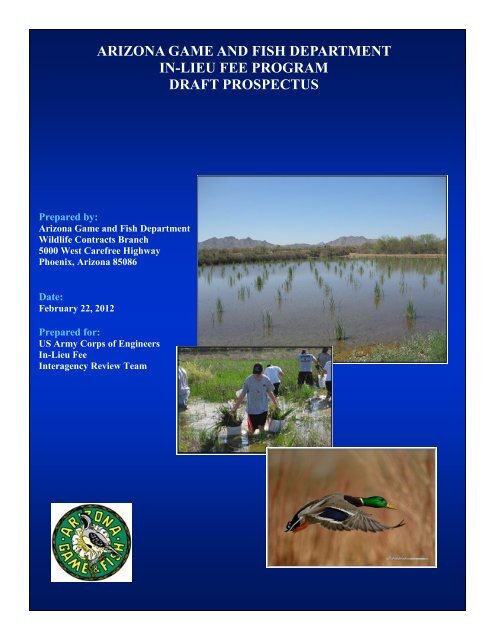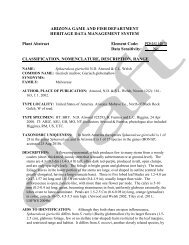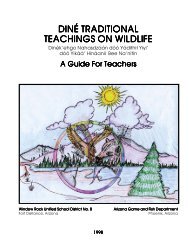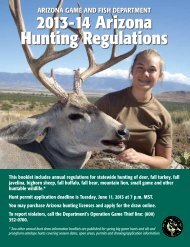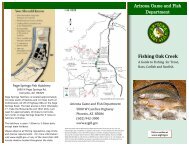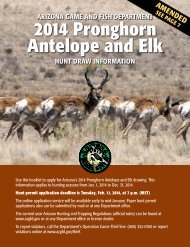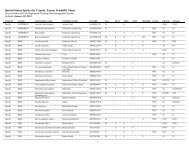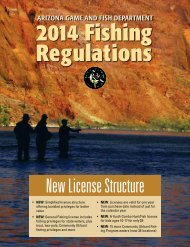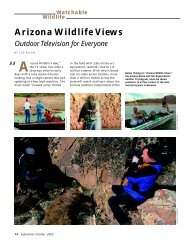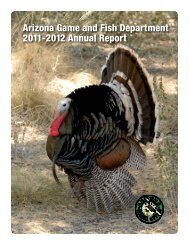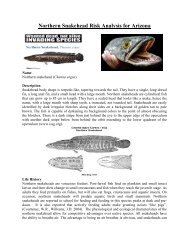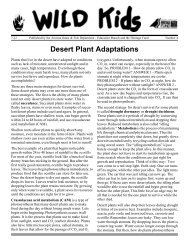ILF - Arizona Game and Fish Department
ILF - Arizona Game and Fish Department
ILF - Arizona Game and Fish Department
Create successful ePaper yourself
Turn your PDF publications into a flip-book with our unique Google optimized e-Paper software.
ARIZONA GAME AND FISH DEPARTMENT<br />
IN-LIEU FEE PROGRAM<br />
DRAFT PROSPECTUS<br />
Prepared by:<br />
<strong>Arizona</strong> <strong>Game</strong> <strong>and</strong> <strong>Fish</strong> <strong>Department</strong><br />
Wildlife Contracts Branch<br />
5000 West Carefree Highway<br />
Phoenix, <strong>Arizona</strong> 85086<br />
Date:<br />
February 22, 2012<br />
Prepared for:<br />
US Army Corps of Engineers<br />
In-Lieu Fee<br />
Interagency Review Team
Draft Prospectus to Establish a State-Wide In-Lieu Fee Program<br />
for the State of <strong>Arizona</strong><br />
Submitted to:<br />
U.S. Army Corps of Engineer, Los Angeles District<br />
Regulatory Branch<br />
Submitted by:<br />
<strong>Arizona</strong> <strong>Game</strong> <strong>and</strong> <strong>Fish</strong> <strong>Department</strong><br />
February 2012<br />
1
Draft Prospectus<br />
For a<br />
State-Wide In-Lieu Fee Program<br />
1. Introduction<br />
The <strong>Arizona</strong> <strong>Game</strong> <strong>and</strong> <strong>Fish</strong> <strong>Department</strong> (<strong>Department</strong>) proposes to establish itself as<br />
statewide sponsor of a US Army Corps of Engineers (Corps) -approved in-lieu fee (<strong>ILF</strong>)<br />
mitigation program. This Draft Prospectus is submitted as a statement of the <strong>Department</strong>’s<br />
commitment, in accordance with the provisions of 33 CFR 332to assume responsibility for,<br />
<strong>and</strong> to implement, perform, <strong>and</strong> conduct the long-term protection <strong>and</strong> management of all inlieu<br />
fee compensatory mitigation projects approved by the Corps <strong>and</strong> accepted by the<br />
<strong>Department</strong> as program sponsor.<br />
2. Objectives<br />
The primary objective of the 2008 regulations for Compensatory Mitigation for Losses of<br />
Aquatic Resources (33 CFR Parts 325 <strong>and</strong> 332) (2008 Rule) is to effectively mitigate for<br />
losses of aquatic resources by utilizing a watershed approach in the planning,<br />
implementation, management <strong>and</strong> long-term protection of mitigation projects. The focus of<br />
the <strong>Department</strong>’s proposed state-wide <strong>ILF</strong> Program will be an overall “no net loss” of aquatic<br />
acreage <strong>and</strong> functions for unavoidable Corps -authorized impacts, unauthorized activities in<br />
waters of the United States, <strong>and</strong> non-compliance issues related to Corps permit conditions.<br />
An Interagency Review Team (IRT), whose members include the Corps, U.S. Environmental<br />
Protection Agency, U.S. <strong>Fish</strong> <strong>and</strong> Wildlife Service, <strong>Arizona</strong> <strong>Department</strong> of Environmental<br />
Quality, Pima County, Pima County Regional Flood Control District, <strong>and</strong> the City of Phoenix<br />
will advise the Corps on the establishment <strong>and</strong> management of the state-wide <strong>ILF</strong> Program.<br />
3. Need for a State-wide <strong>ILF</strong> Program in <strong>Arizona</strong><br />
The need for a strategic <strong>and</strong> comprehensive approach to compensatory mitigation in<br />
<strong>Arizona</strong>’s watersheds is critical, given the historic losses of surface waters <strong>and</strong> related<br />
functions due to dams, incompatible development, water withdrawals, non-native/invasive<br />
species, industrial discharges, incompatible agricultural practices, road construction, fire<br />
suppression, mining, l<strong>and</strong> conversion/development, <strong>and</strong> the future threat of climate change.<br />
The 2008 Rule recognizes that mitigation banks <strong>and</strong> <strong>ILF</strong> programs are environmentally<br />
preferable over permittee-responsible projects, because they involve consolidating<br />
compensatory mitigation projects <strong>and</strong> resources to target more ecologically significant<br />
functions, provide financial planning <strong>and</strong> scientific expertise, reduce temporal losses of<br />
function, <strong>and</strong> reduce uncertainty over project success. At present, no mitigation banks exist<br />
in the State of <strong>Arizona</strong>.<br />
2
The <strong>Department</strong>’s <strong>ILF</strong> Program proposes to utilize a watershed-based approach in selecting<br />
sites based upon need for protection, level of degradation, potential for restoration success<br />
<strong>and</strong>/or habitat values. The <strong>Department</strong> will seek to identify <strong>and</strong> prioritize aquatic resource<br />
restoration, establishment, <strong>and</strong> enhancement activities, as well as preserve existing aquatic<br />
resources to maintain or improve ecological functions of watersheds <strong>and</strong> provide suitable<br />
habitat for federally-listed <strong>and</strong> state species of special concern.<br />
4. Qualifications of Sponsor<br />
The <strong>Department</strong>, a state wildlife resource agency with statutory responsibility to manage <strong>and</strong><br />
conserve wildlife <strong>and</strong> wildlife habitat, is highly experienced in planning, engineering,<br />
implementing <strong>and</strong> managing riparian <strong>and</strong> aquatic habitat for threatened, endangered <strong>and</strong><br />
special status wildlife species in <strong>Arizona</strong>.<br />
The <strong>Department</strong> first accepted in-lieu fees as compensatory mitigation for unavoidable<br />
impacts to aquatic resources in 1998. In 2006, the <strong>Arizona</strong> <strong>Game</strong> <strong>and</strong> <strong>Fish</strong> Commission<br />
entered into the Memor<strong>and</strong>um of Agreement between the U.S. Army Corps of Engineers Los<br />
Angeles District <strong>and</strong> <strong>Arizona</strong> <strong>Game</strong> <strong>and</strong> <strong>Fish</strong> Commission Concerning the Establishment <strong>and</strong><br />
Operation of the AGFD In-Lieu-Fee Mitigation Program.<br />
The Wildlife Contracts Branch will implement the <strong>ILF</strong> program under the 2008 Rule.<br />
Senior staff members in the Wildlife Contracts Branch will be the Project Leads for the<br />
<strong>ILF</strong> Program. Six employees hold a PhD or a Masters degree in the field of wildlife<br />
management <strong>and</strong> ecology. Collectively, they bring over 30 years of experience in Clean<br />
Water Act Section 404 mitigation planning, implementation <strong>and</strong> wetl<strong>and</strong>/riparian<br />
restoration.<br />
<strong>Department</strong> Wildlife Specialists, whose area of expertise best suits individual sitespecific<br />
projects, will serve as technical managers. Wildlife Specialists typically<br />
supervise, organize, plan, analyze <strong>and</strong> conduct complex <strong>and</strong> significant wildlife research,<br />
management or environmental studies in the field. Their duties include developing or<br />
reviewing recommendations <strong>and</strong> reports on wildlife surveys, habitat evaluations, special<br />
studies <strong>and</strong>/or environmental inventories; managing budgets, <strong>and</strong> supervising staff.<br />
Wildlife Specialists will be responsible for preparing mitigation plans <strong>and</strong> monitoring<br />
reports <strong>and</strong> providing site -specific management of each mitigation project.<br />
The <strong>ILF</strong> Program administrative manager will be a Wildlife Specialist III, who will be<br />
responsible for all recordkeeping, credit tracking, credit sales, tracking of projects, database<br />
tracking of completed <strong>and</strong> potential mitigation sites <strong>and</strong> other administrative duties.<br />
The Wildlife Contracts Branch Chief will be responsible for reviewing all proposed<br />
mitigation projects to ensure they comply with the 2008 Rule <strong>and</strong> Corps guidelines <strong>and</strong><br />
directives, <strong>and</strong> are consistent with the <strong>Department</strong>’s mission.<br />
The <strong>Department</strong> has carefully reviewed the 2008 Final Rule for Compensatory Mitigation<br />
For Losses of Aquatic Resources, <strong>and</strong> employees of the Wildlife Contracts Branch have<br />
attended ACOE-sponsored In-Lieu Fee training courses <strong>and</strong> workshops in Tucson, <strong>Arizona</strong><br />
3
<strong>and</strong> Costa Mesa, California. The <strong>Department</strong> believes it is fully capable of assuming the<br />
responsibilities as an <strong>ILF</strong> program sponsor of a watershed-based approach to compensatory<br />
mitigation projects to achieve “no net loss” of wetl<strong>and</strong> acreage <strong>and</strong> function.<br />
5. <strong>Department</strong>’s current <strong>ILF</strong> projects<br />
The Wildlife Contracts Branch is currently implementing an in-lieu fee project at<br />
Chevelon Wildlife Area Wetl<strong>and</strong>s. Tasks completed include surveys for Southwestern<br />
willow flycatcher <strong>and</strong> other passerine birds; an assessment for Threatened <strong>and</strong><br />
Endangered species; a feasibility report, including an evaluation of water storage <strong>and</strong><br />
delivery systems for implementing three wetl<strong>and</strong> restoration design alternatives;<br />
installation of a wildlife friendly livestock exclusion fence to protect the site in<br />
perpetuity; <strong>and</strong> soil sampling to identify areas conducive to propagation of cottonwood<br />
study plots. Four cottonwood study plots have been established. In spring 2011, 1800<br />
cottonwoods were planted <strong>and</strong> invasive vegetation removed. Tasks currently underway<br />
include a 60 percent design plan for wetl<strong>and</strong> <strong>and</strong> riparian corridor areas. Evaluation of<br />
these plots (in conjunction with the Cottonwood Ecology Group at Northern <strong>Arizona</strong><br />
University) will aid the <strong>Department</strong> in determining the proper genetic strain needed to reestablish<br />
native riparian vegetation.<br />
Another ongoing in-lieu fee project is located at the Powers Butte Wildlife Area just<br />
outside Buckeye, <strong>Arizona</strong> in Maricopa County. For this project, the <strong>Department</strong> has<br />
conducted Threatened <strong>and</strong> Endangered species <strong>and</strong> baseline pre-restoration surveys for<br />
avian, small mammal, <strong>and</strong> herpetofauna species occurrence. A well <strong>and</strong> irrigation system<br />
has been restored to functionality <strong>and</strong> wetl<strong>and</strong>s contoured. Over twenty-one acres of<br />
native plantings (cottonwood/willow <strong>and</strong> emergent wetl<strong>and</strong>) have been planted <strong>and</strong><br />
maintained <strong>and</strong> five acres of moist soil unit cells established.<br />
The <strong>Department</strong> will be monitoring these areas in the spring of 2012 for success <strong>and</strong><br />
invasive species encroachment. Field preparation of moist soil unit cells is planned for<br />
the fall, <strong>and</strong> a mesquite bosque planted <strong>and</strong> subsequently monitored for invasive species<br />
encroachment.<br />
6. Aquatic Resource Goals <strong>and</strong> Objectives<br />
The goals <strong>and</strong> objectives for the state-wide <strong>ILF</strong> Program are to:<br />
a) Assess ecosystem functions <strong>and</strong> values (not just impacted acreage) of aquatic<br />
resources <strong>and</strong> associated habitats that have been degraded or destroyed as a result<br />
of activities conducted in compliance with or in violation of Section 404 of the<br />
Clean Water Act of 1972 in determining compensatory mitigation requirements.<br />
b) Preserve <strong>and</strong> restore state wetl<strong>and</strong>s <strong>and</strong> other aquatic resources for the benefit of<br />
federally-listed <strong>and</strong> <strong>Arizona</strong> species of special concern.<br />
4
c) Provide a professionally-managed alternative to permittee-responsible compensatory<br />
mitigation.<br />
d) Minimize the temporal loss of functions <strong>and</strong> services by gaining approval of mitigation<br />
sites in advance or concurrently with mitigation needs.<br />
e) Provide projects <strong>and</strong> services to meet current <strong>and</strong> future dem<strong>and</strong> for credits.<br />
f) Achieve verifiable improvements on a watershed basis.<br />
g) Establish a long-term funding mechanism for the protection <strong>and</strong> management of<br />
mitigation projects.<br />
7. Establishment <strong>and</strong> Operation of the State-wide program<br />
a. The Statewide <strong>ILF</strong> Instrument<br />
The structure of the <strong>Department</strong>’s <strong>ILF</strong> Program is outlined in this statewide <strong>ILF</strong> Instrument,<br />
which is intentionally broad <strong>and</strong> will set the framework under which <strong>Department</strong>-sponsored<br />
<strong>ILF</strong> projects will be identified, funded, operated, maintained <strong>and</strong> managed. The <strong>ILF</strong><br />
Instrument will include a compensation planning framework to select, secure, <strong>and</strong><br />
implement aquatic resource restoration, establishment, enhancement, <strong>and</strong> preservation<br />
activities utilizing a watershed approach.<br />
b. Service Areas<br />
Service areas will be sized appropriately to ensure that the aquatic resources provided by an<br />
<strong>ILF</strong> project will effectively compensate for expected adverse impacts. Priority will be given<br />
to compensatory mitigation projects in the same geographic service area where impacts<br />
occur.<br />
AGFD proposes that service areas be the eight watersheds defined by the USGS Hydrologic<br />
Unit Codes (HUC-4) within the State of <strong>Arizona</strong> (Figure 1). These include the Lower<br />
Colorado/Lake Mead (1501), Little Colorado (1502), Lower Colorado (1503), Upper Gila<br />
(1504), Middle Gila (1505), Salt (1506), Lower Gila (1507) <strong>and</strong> Sonora (1508). Proposed<br />
service areas for individual <strong>ILF</strong> projects will be identified in site-specific mitigation plans,<br />
based on an analysis of the extent of ecologically similar areas, the expected amount <strong>and</strong><br />
type of mitigation required in the service area (dem<strong>and</strong>) compared with the aquatic resources<br />
<strong>and</strong> amount of credits that are expected from an <strong>ILF</strong> project, population <strong>and</strong> growth<br />
information, ongoing watershed management programs, <strong>and</strong> the watershed’s compensation<br />
planning framework. Due to the relatively small size of the 1508 HUC, it is proposed that<br />
impacts occurring within that HUC may be mitigated within any of the adjacent HUCs (1504,<br />
1505 or 1507), whichever is most appropriate <strong>and</strong> agreed upon by the Corps. Final service<br />
area determinations will be made by the Corps in consultation with the IRT.<br />
5
Figure 1. <strong>Arizona</strong> Watershed Hydrologic Units Using HUC-4 Unit Code Designations.<br />
The watershed approach to compensatory mitigation includes, to the extent practicable, an<br />
inventory of historic <strong>and</strong> existing aquatic resources, including identification of degraded<br />
aquatic resources, <strong>and</strong> identification of immediate <strong>and</strong> long-term aquatic resource needs<br />
within a given watershed that can be met through mitigation projects. Mitigation planning<br />
efforts for the <strong>ILF</strong> Program will seek to identify <strong>and</strong> prioritize aquatic resource restoration,<br />
establishment, <strong>and</strong> enhancement activities, <strong>and</strong> preservation of existing aquatic resources that<br />
are important for maintaining or improving ecological functions of a watershed.<br />
Proposed service areas for individual <strong>ILF</strong> projects will be identified in mitigation plans.<br />
Priority service areas around the state may be those that have an existing obligation for<br />
mitigation, have an anticipated dem<strong>and</strong> for compensatory mitigation based on possible future<br />
unavoidable impacts, the overall water quality <strong>and</strong> associated habitat values of the proposed<br />
project’s aquatic system to the watershed <strong>and</strong> the need for mitigation based upon the current<br />
or anticipated levels of possible degradation. Mitigation credits will be determined using the<br />
Corp’s permits authorization criteria for ratios <strong>and</strong> credit calculation or other science-based<br />
methodology which the <strong>Department</strong> deems appropriate.<br />
c. Mitigation Plans<br />
Each mitigation project will have a separate mitigation plan prepared by the <strong>Department</strong> for<br />
review <strong>and</strong> approval by the I R T. Mitigation plans will include the plan objectives (with an<br />
emphasis on self-sustaining features once performance objectives are achieved),<br />
compensation planning framework, site selection rationale, the site protection instrument,<br />
6
aseline data, determination of credits <strong>and</strong> how they were calculated; mitigation work plan;<br />
maintenance plan, monitoring criteria <strong>and</strong> requirements, including ecological performance<br />
st<strong>and</strong>ards for determining mitigation success, the long-term management plan <strong>and</strong> long-term<br />
funding mechanisms.<br />
Typical mitigation activities will include xeroriparian or riparian wash restoration,<br />
replacement <strong>and</strong> buffer establishment, cattle exclusion, invasive species removal, wetl<strong>and</strong><br />
creation, enhancement <strong>and</strong>/or restoration, <strong>and</strong> any other projects that may provide an<br />
improved function <strong>and</strong> service to Waters of the United States adjacent habitats. All projects<br />
will involve water quality <strong>and</strong> habitat improvement aspects that will benefit the overall<br />
watershed. Projects may be proposed by the <strong>Department</strong> or by permit applicants such as<br />
private developers, the federal government, state agencies, <strong>and</strong> municipal or county<br />
governments. The <strong>Department</strong> will remain responsible for the implementation, performance,<br />
<strong>and</strong> long-term management of all compensatory mitigation projects.<br />
d. Credit Accounting<br />
The <strong>Department</strong> may only generate credits from an <strong>ILF</strong> project when a net benefit to<br />
aquatic resources is created at a project site. Credit generation may be based on the<br />
st<strong>and</strong>ard mitigation ratios established by the Corps, or based on a functional assessment<br />
<strong>and</strong> evaluation methodology approved by the Corps. Credits may not be sold prior to<br />
approval of the <strong>ILF</strong> Project mitigation plan. Each mitigation plan will include a credit<br />
release schedule referenced to performance st<strong>and</strong>ards.<br />
8. Example of a priority watershed project: The San Pedro River<br />
The San Pedro River is one of the few remaining free-flowing perennial streams in the<br />
southwest <strong>and</strong> its riparian forest supports several endangered species <strong>and</strong> migratory birds.<br />
Total annual streamflow of the San Pedro River at Charleston has decreased by about 66<br />
percent from 1913 to 2002, <strong>and</strong> changes in upl<strong>and</strong> <strong>and</strong> riparian vegetation have been<br />
identified as likely major factors. From 1973 to 1997, the area of grassl<strong>and</strong>s decreased<br />
by 16 percent, the area of desert scrub decreased by 22 percent, <strong>and</strong> the area of upl<strong>and</strong><br />
mesquite woodl<strong>and</strong> increased by 400 percent. The changes in upl<strong>and</strong> vegetation from<br />
grassl<strong>and</strong>s to woody plants can affect high flows (runoff) <strong>and</strong> low flows (ground-water<br />
discharge). Trends in Streamflow of the San Pedro River, Southeastern <strong>Arizona</strong> ( U.S.<br />
Geological Survey Fact Sheet 2006-3004); Trends in Streamflow of the San Pedro River,<br />
Southeastern <strong>Arizona</strong>, <strong>and</strong> Regional Trends in Precipitation <strong>and</strong> Streamflow in<br />
Southeastern <strong>Arizona</strong> <strong>and</strong> Southwestern New Mexico (U.S. Geological Survey<br />
Professional Paper 1712).<br />
The <strong>Department</strong> recently acquired three parcels (<strong>and</strong> associated water rights) along the<br />
lower San Pedro River in connection with a natural resources damages settlement<br />
agreement in bankruptcy proceedings for ASARCO LLC. In re ASARCO LLC, et al.<br />
(Bankr. S. D. Texas No. 05-21207). All three parcels have dense riparian habitat, high<br />
ecological value <strong>and</strong> species diversity, including a high occurrence of endangered<br />
Southwestern willow flycatchers (Empidonax traillii extimus). , neo-tropical migratory<br />
7
irds, nesting raptors <strong>and</strong> various waterfowl species. The properties include a linear<br />
riparian deciduous woodl<strong>and</strong> consisting of approximately three hundred fifty acres of<br />
cottonwood/willow/tamarisk forest flanked by a mesquite bosque ribbon of one hundred<br />
fifty acres. This riparian woodl<strong>and</strong> extends alongside a 7.25 kilometer perennial section<br />
of the San Pedro River. Approximately 30% of the riparian area is covered with<br />
nonnative vegetation, primarily salt cedar (Tamarix spp.). The site borders current Salt<br />
River Project <strong>and</strong> Nature Conservancy mitigation sites that were created from the loss of<br />
wetl<strong>and</strong> habitat that supported the Southwestern willow flycatcher.<br />
In-lieu fee mitigation on these properties could enhance aquatic resource functions <strong>and</strong><br />
contribute towards the conservation of additional riparian habitat for federally<br />
endangered <strong>and</strong> other obligate wetl<strong>and</strong>/riparian species with projects such as salt cedar<br />
removal <strong>and</strong> cottonwood/willow plantings. The <strong>Department</strong> desires to remove <strong>and</strong><br />
replace invasive Tamarisk with native cottonwood <strong>and</strong> willow plantings. As invasive<br />
Tamarisk creates high levels of soil salinity, removal of Tamarisk increases the quantity<br />
<strong>and</strong> quality of available water for the river <strong>and</strong> for native plantings within existing sub<br />
flows.<br />
Under the terms of the bankruptcy settlement agreement, ASARCO <strong>and</strong> its successors<br />
have the exclusive right to conduct ACOE 404 mitigation projects consistent with the<br />
<strong>Department</strong>’s restoration work on the properties on these parcels for a period of five (5)<br />
years from the effective date of the 2009 settlement, <strong>and</strong> a further right of first refusal<br />
regarding mitigation projects that are proposed for the <strong>Department</strong>’s San Pedro<br />
properties <strong>and</strong> have been approved by the relevant government authorities.<br />
In October 2011, the <strong>Arizona</strong> <strong>Game</strong> <strong>and</strong> <strong>Fish</strong> Commission authorized the <strong>Department</strong> to<br />
purchase the Triangle Bar Ranch, which consists of four large parcels totaling<br />
approximately one thous<strong>and</strong> deeded acres with associated water rights along the lower<br />
San Pedro River. Three of the parcels are located across the San Pedro River <strong>and</strong><br />
adjacent to the <strong>Department</strong>’s San Pedro properties. Eight hundred of the acres represent<br />
riparian habitat, with the remaining two hundred acres consisting of upl<strong>and</strong>s.<br />
Improvements to this property under the <strong>ILF</strong> program would be focused on removal of<br />
invasive vegetation <strong>and</strong> improving the connectivity <strong>and</strong> ecosystem functions of the lower<br />
San Pedro River to benefit recovery of species listed under the Endangered Species Act.<br />
9. The In-Lieu Fee Program Account<br />
All <strong>ILF</strong> Funds will be deposited in the <strong>Arizona</strong> <strong>Game</strong> <strong>and</strong> <strong>Fish</strong> Donation <strong>and</strong> Trust Fund<br />
Account (Account), with individual sub-accounts dedicated to specific project sites as<br />
described below. The terms <strong>and</strong> conditions contained in the <strong>ILF</strong> instrument <strong>and</strong><br />
approved mitigation plans will govern authorized fund expenditures, which will be<br />
dedicated to the selection, design, acquisition, implementation <strong>and</strong> management of the inlieu<br />
fee compensatory mitigation projects.<br />
8
The 2008 Rule (33 CFR 332.8.i) requires the <strong>ILF</strong> sponsor to establish a program account<br />
prior to accepting in-lieu fees from permittees. An <strong>ILF</strong> program account has the<br />
following requirements:<br />
1. An account at a FDIC-insured financial institution.<br />
2. All interest <strong>and</strong> earnings accruing to the account must remain in that account for use<br />
by the <strong>ILF</strong> program for compensatory mitigation.<br />
All Corps Section 404 in-lieu fee funds received by the <strong>Department</strong> are considered<br />
private trust funds, defined in A.R.S. § 35-149(A) as funds subject to refund or return to<br />
sender. All in-lieu funds will be deposited in the Account, established pursuant to A.R.S.<br />
§ 35-149(A). This statute authorizes state agencies receiving private funds received for<br />
the purpose of defraying state agency expenses, or for work done under the state agency’s<br />
direction, to open a donation <strong>and</strong> trust fund account with the <strong>Arizona</strong> State Treasurer.<br />
The Treasurer’s Office invests the trust funds in diversified pooled fixed income<br />
investments <strong>and</strong> bonds through the Bank of America, its contracted servicing bank.<br />
A.R.S. § 35-316 authorizes the Treasurer’s Office to establish investment pools for the<br />
collective investment of trust monies held by the State of <strong>Arizona</strong>. The trust funds are<br />
managed by portfolio managers within the Treasurer’s Office.<br />
All in-lieu funds deposited in the Account will have a designated <strong>ILF</strong> subaccount for each<br />
<strong>ILF</strong> project site, which identify the source of the funds; the terms <strong>and</strong> conditions <strong>and</strong> the<br />
purpose for which they were received; the name of the fund administrator (the <strong>Arizona</strong><br />
<strong>Game</strong> <strong>and</strong> <strong>Fish</strong> <strong>Department</strong>) <strong>and</strong> the name of the person authorized to approve<br />
expenditures from the subaccount. All subaccounts are maintained separate <strong>and</strong> distinct<br />
from all other funds in a donation <strong>and</strong> trust fund account. A.R.S. § 35-149(B).<br />
Funds from <strong>Department</strong> trust subaccounts are withdrawn through a requisition <strong>and</strong><br />
invoice process as authorized by a Branch Chief or designee. The <strong>Department</strong> has<br />
multiple internal levels of security <strong>and</strong> authorization in place within its Procurement <strong>and</strong><br />
Accounting Sections. Warrants from subaccounts are issued by the <strong>Arizona</strong> <strong>Department</strong><br />
of Administration.<br />
The Treasurer’s Office issues monthly statements for all state agency Donation <strong>and</strong> Trust<br />
Fund accounts, <strong>and</strong> credits all such funds with accrued earnings <strong>and</strong> interest based on the<br />
principal amount of each fund balance. A.R.S. § 35-316(C). Earnings <strong>and</strong> interest are<br />
thereafter allocated to the various subaccounts within the Account in proportion to the<br />
funds credited to each subaccount.<br />
As all <strong>ILF</strong> funds, including principal, accrued earnings <strong>and</strong> interest in the Account’s<br />
subaccounts are designated private trust funds by operation of law, such funds are not<br />
subject to legislative appropriations or “sweeps”.<br />
9
10. Long Term Management Strategies<br />
The <strong>Department</strong> will assume responsibility for ensuring the long-term protection of each<br />
<strong>ILF</strong> project as a functioning aquatic resource. Adequate long-term financing mechanisms are<br />
an essential component for project success. One method is to include in the cost of each<br />
credit released an appropriately calculated percentage to build an endowment trust to provide<br />
income for long-term management <strong>and</strong> monitoring of mitigation projects. The Wildlife<br />
Contracts Branch is analyzing methods of long-term management funding, including<br />
methods of calculating annualized stewardship <strong>and</strong> organizational costs based on a<br />
software program by the Center for Natural L<strong>and</strong>s Management (Version 1.03 2007).<br />
11. Site Protection Requirements<br />
The type of ownership <strong>and</strong> long-term management strategy will vary by mitigation<br />
project site.<br />
The 2008 Rule, 33 C.F.R. 332.3(h) requires the project site to be permanently protected<br />
through an appropriate real estate or other legal instrument (e.g., easement, title transfer<br />
to state resource agency or l<strong>and</strong> trust).<br />
The Rule at 33 CFR 332.7 assumes that title ownership alone of a project site by a<br />
resource agency provides the necessary long-term site protection, based on the<br />
assumption that a resource agency or non-profit is committed to long-term protection of<br />
the project <strong>and</strong> would not act in a manner contrary to that interest. The <strong>Department</strong> is a<br />
state resource agency with statutory responsibility to manage <strong>and</strong> conserve <strong>Arizona</strong><br />
wildlife <strong>and</strong> wildlife habitat. That responsibility would include the management<br />
consistent with the terms <strong>and</strong> conditions of any mitigation <strong>and</strong> long-term management<br />
plan approved by the Corps in connection with a compensatory mitigation project<br />
situated on <strong>Department</strong>-owned property.<br />
Where an <strong>ILF</strong> mitigation project is or has been placed on <strong>Department</strong>-owned property, no<br />
additional recorded site protection measures are necessary. In the event the <strong>Department</strong><br />
proposes any incompatible change in use of <strong>Department</strong>-owned property set aside for<br />
compensatory mitigation, the <strong>Department</strong> will assume the responsibility to submit<br />
alternative compensatory mitigation proposals acceptable to the ACOE.<br />
For privately-owned l<strong>and</strong>s upon which an <strong>ILF</strong> mitigation project is proposed, the<br />
<strong>Department</strong>, as <strong>ILF</strong> sponsor, will draft <strong>and</strong> record a perpetual Deed of Conservation<br />
Easement in a form acceptable to Corps <strong>and</strong> thereafter monitor <strong>and</strong> enforce the deeded<br />
permanent site protections.<br />
<strong>Arizona</strong> Revised Statutes §§ 33-271 through 33-276 authorize the use of conservation<br />
easements to preserve <strong>Arizona</strong>’s natural ecosystems. The <strong>Department</strong> is qualified to act<br />
as a “holder” of a conservation easement pursuant to A.R.S. §§ 33-271 <strong>and</strong> is a<br />
“qualified organization” within the provisions of Sections 170(b)(1)(A)(v), 170(h) <strong>and</strong><br />
10
170(c) of the Internal Revenue Code of 1986, as amended, qualified to acquire <strong>and</strong> hold<br />
conservation easements.<br />
12. Program Reporting<br />
The <strong>Department</strong> will submit to the District Engineer an annual report ledger showing the<br />
beginning <strong>and</strong> ending balance of available credits <strong>and</strong> permitted impacts for each<br />
resource type, all additional <strong>and</strong> subtractions of credits, <strong>and</strong> other changes in credit<br />
availability in accordance with 33 CFR 332.8(q).<br />
The <strong>Department</strong> will also submit annual reports with the following information for each<br />
<strong>ILF</strong> project in accordance with 33 CFR 332.8(i)(3):<br />
1. The Corps’ permit number.<br />
2. The service area; the amount of authorized impacts, the amount of required<br />
compensatory mitigation.<br />
3. The balance of advance credits <strong>and</strong> released credits at the end of the report period for<br />
each service area.<br />
4. A statement of activities performed for the reporting period.<br />
5. A monitoring report with a comparison to performance st<strong>and</strong>ards.<br />
6. An explanation if performance st<strong>and</strong>ards are not being met; any proposed site<br />
modifications, design changes, revisions to maintenance requirements, <strong>and</strong>/or revised<br />
monitoring requirements; <strong>and</strong> any adaptive management strategies undertaken or planned<br />
for the upcoming year.<br />
7. Plans, maps, <strong>and</strong>/or photographs to illustrate site conditions.<br />
13. Financial Reporting<br />
The <strong>Department</strong> will also submit an annual financial reporting statement for each <strong>ILF</strong><br />
project. The report shall describe all income, disbursements, <strong>and</strong> interest earned with<br />
respect to each <strong>ILF</strong> Project subaccount for the state’s previous fiscal year (July 1 to June<br />
30).<br />
The statement will detail all income, disbursements <strong>and</strong> interest earned in each <strong>ILF</strong><br />
subaccount within the Account, including date(s) in-lieu-fee monies were received <strong>and</strong> a<br />
breakdown of expenditures (cost of l<strong>and</strong> acquisition, project planning, construction,<br />
monitoring, maintenance, contingencies <strong>and</strong> administration).<br />
The statement will also include the <strong>Department</strong>’s evaluation of the adequacy of the<br />
funding mechanisms for future long-term management activities, given the effects of<br />
increased costs related to mitigation activities, interest rates <strong>and</strong> the current state of the<br />
economy.<br />
The Corps will retain the right to audit all books <strong>and</strong> records of the <strong>Department</strong> upon<br />
reasonable prior notice. Pursuant to A.R.S. §§ 35-214 <strong>and</strong> 35-215 <strong>and</strong> A.R.S. § 41-<br />
11
1279.04, as amended, all books, accounts, reports, files, <strong>and</strong> other records of the<br />
<strong>Department</strong> shall be subject at all reasonable times to inspection <strong>and</strong> audit by the Corps.<br />
The <strong>Department</strong> shall also provide for access to project sites by IRT members or their<br />
designees at reasonable times as necessary to conduct inspections <strong>and</strong> compliance<br />
monitoring.<br />
2. <strong>ILF</strong> Contacts<br />
AGFD Contacts<br />
Tim Wade -Wildlife Contracts Branch Chief<br />
<strong>Arizona</strong> <strong>Game</strong> <strong>and</strong> <strong>Fish</strong> <strong>Department</strong><br />
5000 W. Carefree Highway<br />
Phoenix, AZ 85086<br />
623-236-7247 office<br />
602-828-4239 cell<br />
623-236-7918 fax<br />
twade@azgfd.gov<br />
Renee Wilcox<br />
Wildlife Contracts<br />
<strong>Arizona</strong> <strong>Game</strong> <strong>and</strong> <strong>Fish</strong> <strong>Department</strong><br />
5000 W. Carefree Highway<br />
Phoenix, <strong>Arizona</strong> 85086<br />
623-236-7306 office<br />
623-236-7918 fax<br />
520-591-9306 cell<br />
rwilcox@azgfd.gov<br />
12


